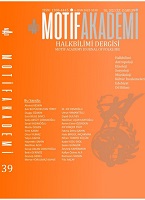CENGİZ AYTMATOV’UN DENİZ KIYISINDA KOŞAN ALA KÖPEK ROMANINDA MEKÂNIN RUHU VE “KENDİLEME” KAVRAMI
THE SPIRIT OF THE SPACE AND THE CONCEPT OF “OWNING” IN CENGİZ AYTMATOV'S NOVEL DENİZ KIYISINDA KOŞAN ALA KÖPEK
Author(s): Serap Aslan CobutoğluSubject(s): Philosophy, Turkish Literature, Sociology of Literature
Published by: Motif Halk Oyunları Eğitim ve Öğretim Vakfı
Keywords: Chingiz Aitmatov; A Dog Running on the Seashore (Deniz Kıyısında Koşan Ala Köpek); the spirit of the space; the concept of "appropriation";
Summary/Abstract: Cengiz Aytmatov, who is one of the distinguished writers not only of Kyrgyz literature but also of all Turkish world literatures, is known to have special interactions between space and people in many of his works. It is possible to say that one of the main pillars of the author, who develops an eye-opening understanding of human psychology in his works, is the knowledge of geography, nature, space and place to which he is passionately attached. In this respect, the spatial elements in the works of the author, who are seen to deal with issues such as environmental problems and the deterioration of the human essence in parallel with the deterioration of the natural balance, in his stories and novels appear as the main determinants in reaching "human" and understanding "human". It is certain that detailed spatial studies on Aitmatov's works will create awareness in terms of understanding the author and the characters he creates in his works. In this respect, this article focuses on the subject of space and identity in Cengiz Aytmatov's novel The Ala Dog Running on the Seashore. The character of the place in the work has dimensions beyond visual and spatial features. It is seen that many spatial units of nature are symbolized through an identity value and take place in the novel as a spiritual value in terms of culture. Every effort to glorify and mythologize the place in the work has resulted in the place gaining a unique identity and its inhabitants owning it. This situation shows parallelism with the phenomenon of "owning" the place where people live. Spatial units, which are mostly told from the eyes and point of view of the child character Kirisk in the novel, are shaped around the concept of "owning" through place identity. In this context, in this article, the identity value of the place in the work is read through the phenomenon of place identity and the process of transition from place identity to identity around the concept of "owning" is mentioned.
Journal: Motif Akademi Halkbilimi Dergisi
- Issue Year: 15/2022
- Issue No: 39
- Page Range: 883-907
- Page Count: 25
- Language: Turkish

